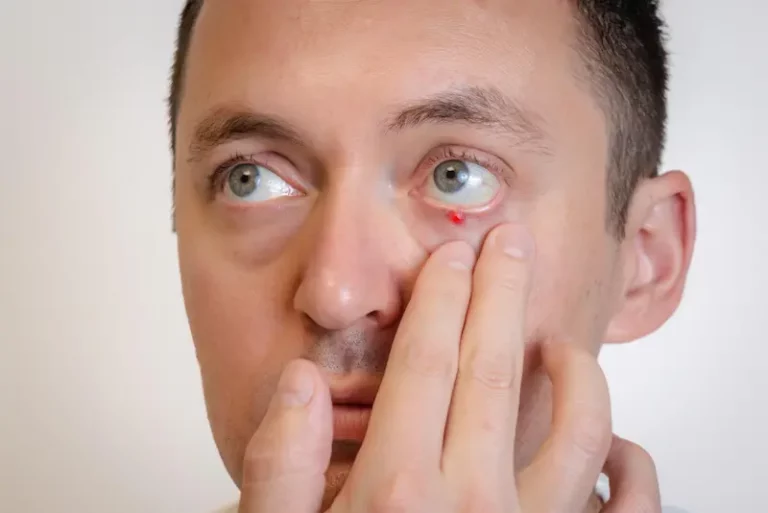
Chalazion: Causes, Symptoms, Treatments and Prevention
A Chalazion is a small, chronic cyst of the eyelid caused by an obstruction of the meibomian gland . Benign, but sometimes unsightly or embarrassing, it affects both adults and children. Given the high level of competition on this topic, we have gathered all the useful information in this guide: causes, symptoms, medical or surgical treatments, prevention and a comprehensive FAQ .
1. What is a chalazion?
A chalazion is a non-infectious cyst resulting from sterile inflammation. When
the meibomian gland becomes blocked, sebum (meibum) accumulates and forms a small,
rounded, more or less red swelling on the upper or lower eyelid.
2. Why does it form? (pathophysiology)
Meibomian gland dysfunction (MGD)
Seborrhea, ocular rosacea or seborrheic dermatitis
Prolonged wear of lenses or makeup not removed
Mechanical stress (eyelid rubbing)
A chalazion is a growth that occurs on the eyelid. It's usually caused by a clogged oil gland within the eylid. While typically benign, chalazia can be irritating and impact your vision if they become large or {presson the eye.
Symptoms of a chalazion include redness around the affected eyelid. The lump may also be tender to the touch, and you might experience vision changes if the chalazion is pressing on your eye.
- Warm compresses can help soften the blockage in the oil gland.
- If a warm compress doesn't resolve the chalazion, your ophthalmologist may recommend a prescription medication to fight infection
- {In some cases|Rarely, surgical drainage might be necessary to remove the blockage in the oil gland.
It's important to schedule an appointment if you experience any symptoms of a chalazion. Prompt evaluation can help prevent complications and restore your vision.
Chalazion: When an Eyelid Gland Goes Wrong
A chalazion is a tender lump that forms on the eyelid. It occurs when an oil gland in the eyelid is obstructed. This blockage causes a buildup of oil and debris, which gradually hardens into a solid bump. Chalazions are often diagnosed and usually mild.
In most cases, chalazions resolve on their own within a few weeks or months. However, if it's large, painful, or causing vision problems, you should see an ophthalmologist. They may recommend solutions such as warm compresses, eyelid massage, or in uncommon cases, surgery to remove the chalazion.
Relief from Chalazia: Home Remedies and Medical Options
Chalazia are small bumps that develop on the eyelids, often causing discomfort. While usually harmless, they can be annoying and affect your vision if large or located in a sensitive area. Fortunately, there are numerous options for relieving chalazia symptoms, both at home and through medical intervention.
Over-the-counter treatments can often provide soothing relief. Applying a warm compress to the affected area once or twice for 20 minutes at a time can assist in softening the chalazion and promoting drainage.
Besides that, you can try using over-the-counter antibacterial ointment to reduce inflammation and infection risk. If home remedies fail to provide sufficient relief, your eye care professional may recommend more direct treatment options. These can include prescription eye drops or in rare cases, a minor surgical procedure to drain the chalazion.
Spotting the Difference: Chalazion vs. Stye
A chalazion and a stye are both common orbital infections, but they have distinct causes and symptoms. A cyst forms when an oil gland in the eyelids becomes blocked, resulting in a slow-growing, sensitive lump under the skin. In contrast, a stye, also known as a bacterial infection, is caused by a microbial contamination of an oil gland or hair follicle on the palpebral. This leads to a painful red bump that may contain pus and often resolves within days.
- To diagnose these conditions, a doctor will examine the lump and consider your symptoms. Treatment for a chalazion typically involves warm compresses and possibly an drainage, while a stye may be treated with warm compresses, antibiotic eye drops, or even a prescription.
Preventing both chalazia and styes involves practicing good eyelid hygiene, such as gently washing your eyelids with mild soap and water daily. Avoid touching your eyes frequently and keep your hands clean to minimize the risk of infection.
Preventing Chalazia: Tips for Strong Eyelids
Chalazia, those pesky bumps on your eyelid, can be a real nuisance. Fortunately, there are several things you can do to reduce your risk of developing them. Start by practicing good eyelid hygiene. Gently scrub your eyelids daily with a mild soap. Avoid rubbing or touching your eyes excessively, as this can irritate the oil glands and lead to chalazia formation. One more helpful tip is to apply a warm compress to your eyelid several times a day. This can help melt the blockage in the oil gland, making it easier for the substance to drain. If you notice a chalazion forming, see your eye doctor promptly for recommendations.
- Utilize oil-free cosmetics and makeup removers.
- Remove eye makeup before bed every night.
- Stay hydrated by drinking plenty of water throughout the day.
Living a Chalazion: Managing Pain and Discomfort
Dealing due to a chalazion can be troublesome. These tiny lumps on your eyelid can cause check here discomfort, making it difficult to focus. While most chalazia resolve on their own, there are some methods you can do to ease the pain and discomfort.
- Using a warm compress several times a day can help to loosen the chalazion and speed up healing.
- Medicinal pain relievers like ibuprofen or acetaminophen can reduce inflammation and pain.
- Avoiding the chalazion as much as possible to prevent infection.
- If the chalazion is large, painful, or causing vision problems, see an eye doctor for treatment options.
Comments on “Delving into Chalazia: A Guide to Causes, Symptoms, and Treatment”